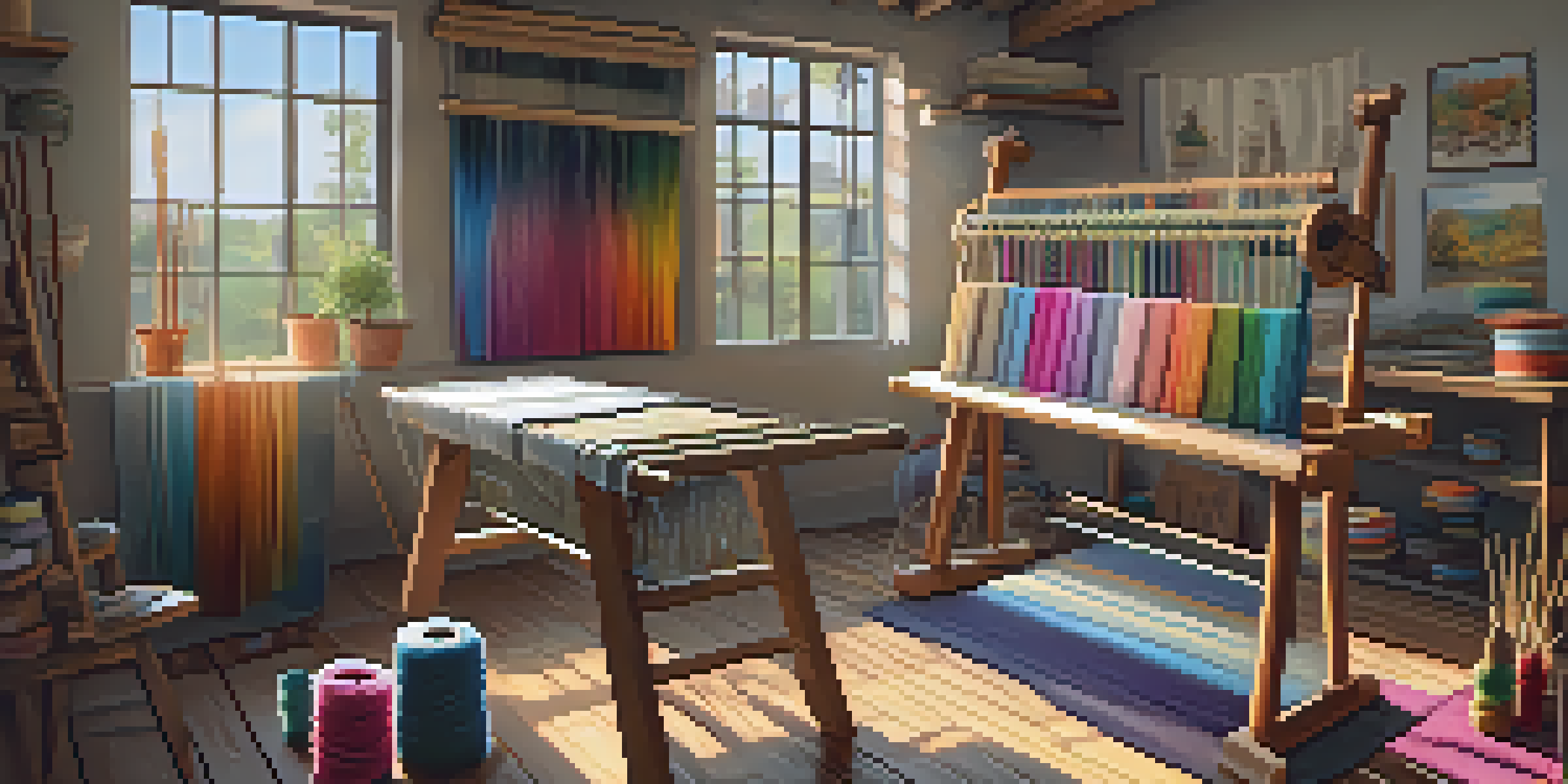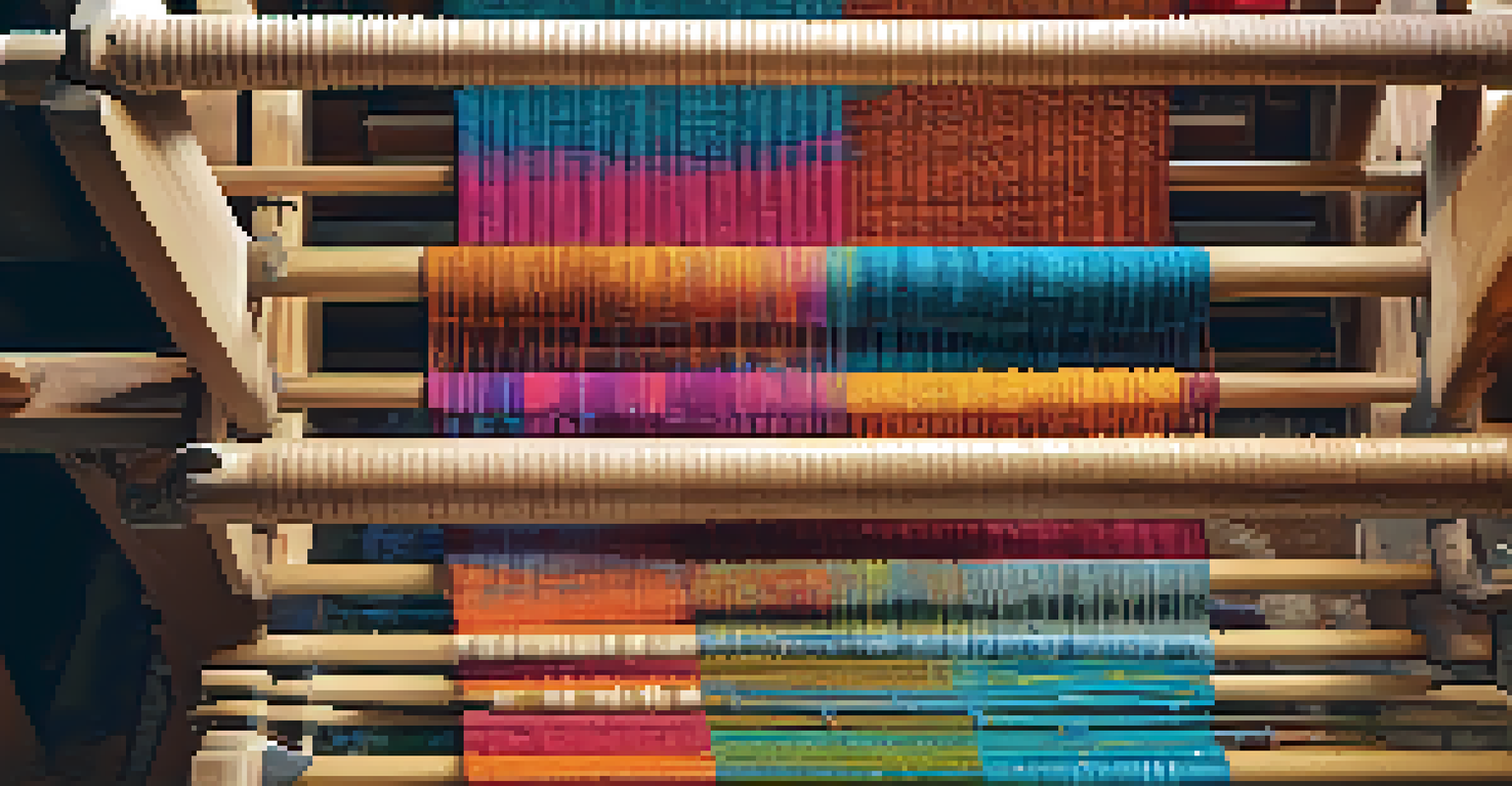Step-by-Step Guide to Weaving Your First Area Rug

Understanding the Basics of Rug Weaving
Before diving into weaving, it’s essential to grasp the basics. Rug weaving is an age-old craft that combines creativity and skill, allowing you to create a unique piece of art for your home. At its core, it involves interlacing threads to form a durable fabric, and the beauty lies in the patterns and textures you can create.
Weaving is like dreaming; it is a way to capture the intangible and make it tangible.
There are various techniques and styles of weaving, including hand-knotting, tufting, and flat-weaving. Each method has its unique characteristics, so take some time to research which style resonates with you. Understanding these fundamentals will set the stage for a successful weaving experience.
As you embark on this journey, keep in mind that practice makes perfect. Your first rug may not be flawless, but that’s part of the learning process. Embrace the opportunity to develop your skills and express your creativity through this timeless craft.
Gathering Your Weaving Supplies
To start your rug weaving project, you'll need to gather the right supplies. Essential tools include a loom, yarn, scissors, and a weaving needle. Depending on your chosen technique, you may also need a rug hooking tool or a latch hook if you’re tufting.

Selecting the right yarn is crucial for the durability and aesthetics of your rug. Consider wool for a warm, natural feel or synthetic fibers for easy maintenance. The color and texture of your yarn will significantly influence the final look, so don’t hesitate to experiment with combinations.
Master Rug Weaving Basics
Understanding techniques like hand-knotting and tufting is essential for a successful weaving experience.
Lastly, don’t forget about your workspace. A comfortable and organized area will enhance your focus and creativity. Lay out your tools and materials so you can easily access them as you weave, making the process smoother and more enjoyable.
Choosing a Design for Your Area Rug
Once you've got your supplies, it's time to choose a design for your rug. Think about where you’ll place the rug and the overall style of your home. Whether it's a bold geometric pattern or a soft floral design, your rug should complement your space.
Creativity takes courage.
Sketching your design on paper can help visualize the final product. You can also use graph paper to plot out the colors and shapes, ensuring that every detail is accounted for. Don’t shy away from incorporating personal elements, as this will make your rug truly unique.
Consider starting with a simple design for your first rug. This will make the process more manageable and enjoyable, allowing you to build confidence before tackling more intricate patterns. Remember, the goal is to create something that brings joy and warmth to your home.
Setting Up Your Loom for Weaving
With your design in hand, it's time to set up your loom. The loom is your workspace where the magic happens, so understanding how to properly assemble it is key. Follow the manufacturer's instructions to ensure everything is in place before you start weaving.
Once your loom is set up, you’ll need to warp it, which means threading the yarn through the loom’s framework. This creates the foundation for your rug and is a crucial step. Take your time here; a well-warped loom leads to smoother weaving.
Gather Essential Weaving Tools
Having the right supplies, including a loom and quality yarn, is crucial for creating a beautiful rug.
After warping, check for any tension issues. The yarn should be taut but not overly tight. Adjusting the tension will impact the quality of your weaving, so it’s worth spending a few extra moments getting this right.
Learning Basic Weaving Techniques
Now that your loom is ready, it's time to learn some basic weaving techniques. Depending on the style you're going for, you might start with a simple over-under technique, which is the foundation of most weaving patterns. This technique involves alternating the yarn over and under the warp threads.
Practice makes perfect, so start with a small section to get a feel for how the yarn moves through the loom. Don’t worry if your first few rows are uneven; this is part of the learning curve. With each pass, you’ll gain more control and confidence.
As you become more comfortable, consider experimenting with color changes and textural variations. This will not only enhance the visual appeal of your rug but also allow for greater expression of your personal style.
Finishing Your Area Rug with Style
As you approach the end of your weaving process, it’s time to focus on finishing your rug. This step is just as important as the weaving itself, as it will determine the durability and appearance of your final product. Begin by carefully cutting the yarn from the loom, ensuring you leave enough length for finishing techniques.
One popular method is to weave in the loose ends, creating a clean and polished look. You can also choose to add a border or fringe to give your rug a more finished appearance. These little details can elevate your rug from a simple craft project to a stunning piece of decor.
Care for Your Handwoven Rug
Proper care, such as regular vacuuming and mindful placement, will help maintain your rug's beauty and longevity.
Lastly, don’t forget to give your rug a good shake and a gentle wash if needed. This will help remove any dust or debris accumulated during the weaving process and will refresh the texture and color of your rug.
Caring for Your Handwoven Area Rug
Congratulations on completing your first area rug! Now that you have a beautiful piece to display, it’s important to care for it properly to ensure its longevity. Regular vacuuming is key to keeping your rug clean and free of dust; just remember to use a vacuum without a beater bar to avoid damaging the fibers.
In addition to vacuuming, consider rotating your rug every few months. This helps prevent uneven wear and fading from sunlight. If your rug begins to show signs of wear or dirt, spot cleaning with a mild detergent and water can help restore its beauty.

Lastly, be mindful of the environment in which your rug is placed. Keeping it away from direct sunlight and high-traffic areas will help maintain its appearance and durability for years to come. Enjoy your handcrafted creation and the warmth it brings to your home!